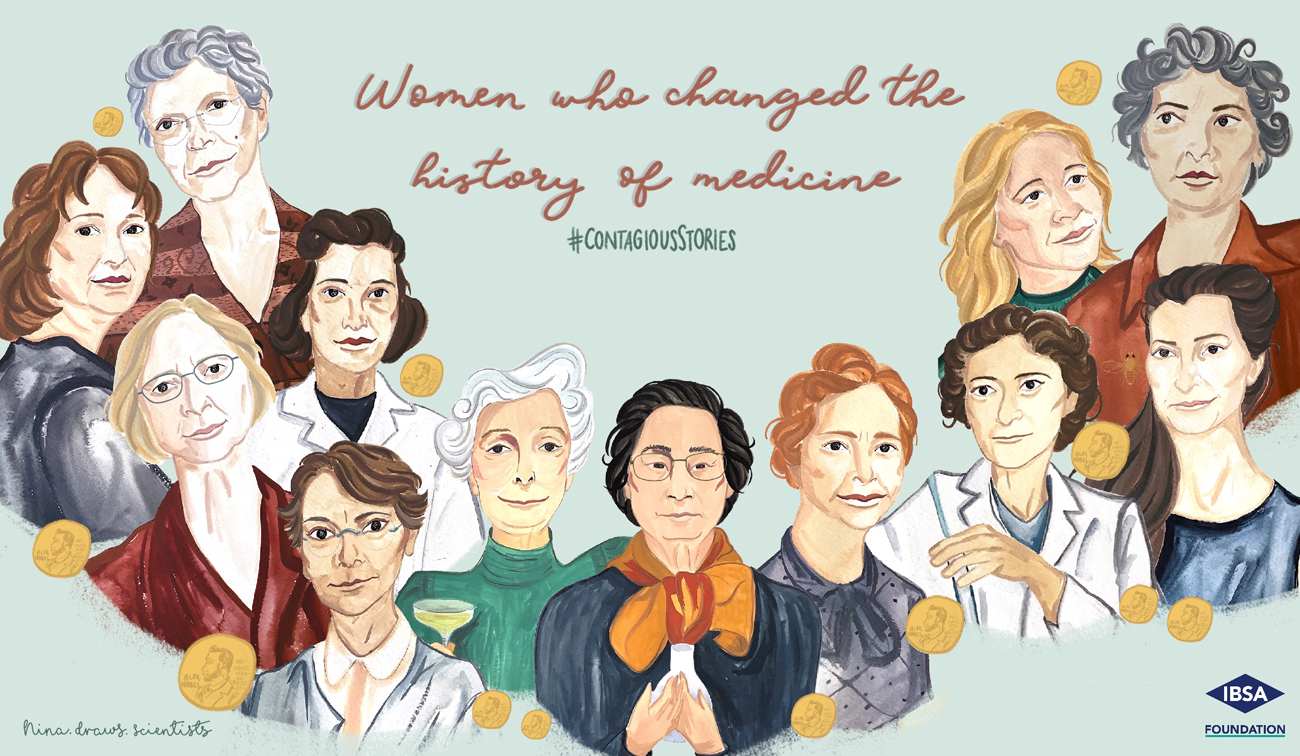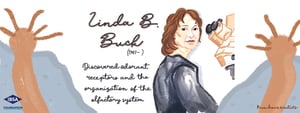Linda B. Buck won the Nobel Prize for Medicine in 2004, together with Richard Axel, for her work on olfactory receptors and for isolating the genes that, when we smell a certain scent, enable us to recognize it again in the future.
Her research revealed the incredible similarity between species, producing the theory that the basic principles of odor discrimination have been preserved for millions of years.
Linda’s story
It may be that my parents’ interest in puzzles and inventions planted the seeds for my future affinity for science, but I never imagined as a child that I would someday be a scientist.
[Linda B. Buck]
Linda was born in Seattle in 1947. Her mother was a housewife who loved doing word puzzles. Her father was an engineer who spent his free time inventing and building things in their garage. Since childhood she dreamt of helping others and, when she finished high school, she decided to study psychology in order to become a psychotherapist.
While at university, however, her vocation for science became very apparent. In 1975 she graduated with a degree in both psychology and biology, and continued her studies at the immunology laboratory of the University of Texas Southwestern Medical Center in Dallas. There, with the help of her thesis advisor Ellen Vitetta, she learnt to do research and conduct experiments.
Linda subsequently perfected the techniques of molecular biology at the laboratory run by Richard Axel, who was studying the nervous system of the Aplysia, a sea snail.
In particular, Linda was fascinated with the mechanisms that regulate the perception of smell. This is how she began to wonder how mammals and humans were able to detect and memorize more than 10,000 different smells.
By studying the olfactory receptors in mice, Linda discovered that they have approximately 1000 genes that control an equivalent number of olfactory receptors, all different, located in the cells of a small area of the nasal epithelium. Humans have far fewer receptors (350 compared to 1000), but they work in the same way.
In 1991, she published her work on the organization of the olfactory system in the journal ‘Cell’ together with Richard Axel, which resulted in both of them being awarded the Nobel Prize for Medicine.
In 2001, having become a full professor at Harvard, Linda published new research on how olfactory neurons are mapped in the cerebral cortex, studying the profound effects of smell on the brain in terms of attraction and aversion, memory and emotion.
Her personality
Linda had a happy childhood. Her parents taught her to think independently, urging her to do something worthwhile with her life to “not settle for something mediocre”. These teachings have always influenced her work as a scientist.
She considers herself to be very lucky, because very few have had the opportunity to do what they love everyday, as she has. Her motto is:
Do something that you’re obsessed with, because that’s where the great discoveries come from.
[Linda B. Buck]
Linda loves doing jigsaws and puzzles. In her work, she appreciates in particular the fact that she has had amazing mentors, colleagues and students with whom to explore what fascinates her. She loves challenges and cannot wait to find out what new surprises nature has in store for us in the future.
She has always been committed to full gender equality in the scientific world. When she won the Nobel Prize, she said:
As a woman in science, I sincerely hope that my receiving a Nobel Prize will send a message to young women everywhere that the doors are open to them and that they should follow their dreams.
[Linda B. Buck]
Her research
How could humans and other mammals detect 10,000 or more odorous chemicals, and how could nearly identical chemicals generate different odor perceptions? In my mind, this was a monumental puzzle and an unparalleled diversity problem.
[Linda B. Buck]
Thanks to Linda’s work, it was discovered that each cell in the nasal cavity is associated with a specific receptor, which specializes in the recognition of a wide range of different smells. When the molecules coming from the air outside combine with the nasal receptors, the cells send a series of electric signals at the olfactory bulb in the brain, which then reprocesses all the information received and produces the perception of a well-defined odor.
In practice, by working together, the receptors create a combinatorial code, forming an odorant pattern. This code underlies our ability to recognize more than 10,000 different smells, just like we are able to spell thousands of words using just the 26 letters of the alphabet.
Today, Linda continues to study the olfactory system, but is also involved in new research activities that explore the ageing of the brain, the functioning of cognitive abilities and the mechanisms of memory.
Discover the other stories of the women who changed the history of medicine

 Nina Chhita is the artist and illustrator of the Instagram account @nina.draws.scientists, which focuses on contemporary and historical trailblazing scientists, who happen to be women. She initially started the account as a way to discover historical figures, and as a scientist herself, naturally gravitated towards scientists. Articles have since been written about Nina in the BBC news and Mental Floss. Her illustrations have appeared on the social media sites of the University of Oxford, the University of Bath, Dementias Platform UK, and in a YouTube video by Vanessa Hill. She lives in Vancouver where she works as a medical writer creating educational content for healthcare professionals.
Nina Chhita is the artist and illustrator of the Instagram account @nina.draws.scientists, which focuses on contemporary and historical trailblazing scientists, who happen to be women. She initially started the account as a way to discover historical figures, and as a scientist herself, naturally gravitated towards scientists. Articles have since been written about Nina in the BBC news and Mental Floss. Her illustrations have appeared on the social media sites of the University of Oxford, the University of Bath, Dementias Platform UK, and in a YouTube video by Vanessa Hill. She lives in Vancouver where she works as a medical writer creating educational content for healthcare professionals.


